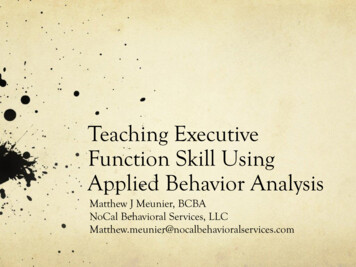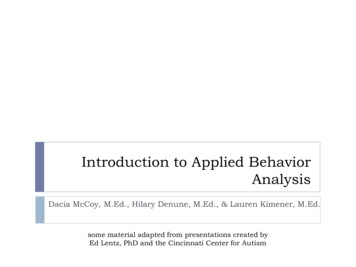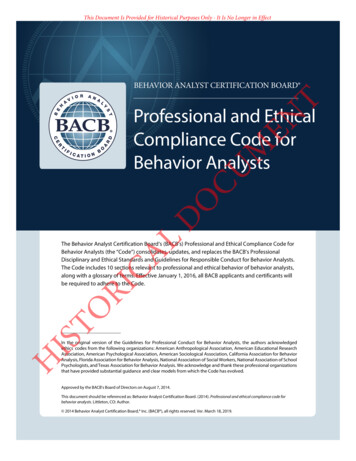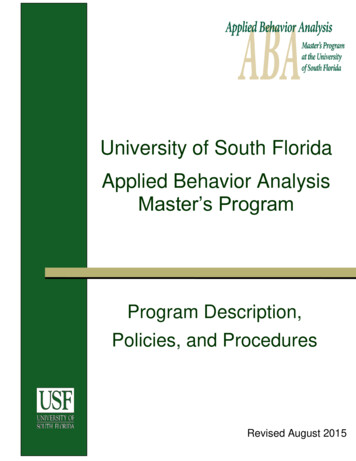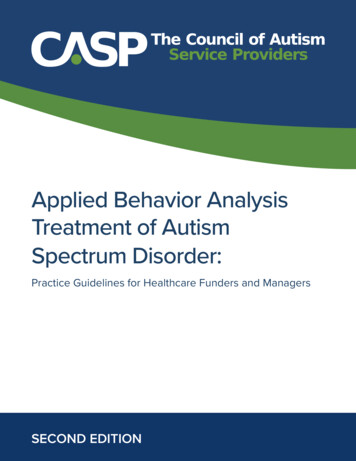
Transcription
The ABCs of Behavior AnalysisAn Introduction toLearning and BehaviorA. Charles CataniaALL FRONT MATTER DELETED EXCEPT THISPAGE, ToC, AND ix, WHICH NEEDS A FIX.NOTES AT THE START OF CHAPTERS SHOWWHERE CORRECTIONS ARE NEEDED ANDINDICATE WHICH PAGES HAVE BEENDELETED.2017Sloan PublishingCornwall on Hudson, NY 12520
ContentsPreface for Student ReadersPreface for All ReadersixPart I. Introduction1. Learning and Behavior2. A Behavior Taxonomyvii18Part II. Behavior Without Learning3. Evolution and Development184. Motor and Sensory Systems275. Elicited and Emitted Behavior38Part III. Learning Without Words: Consequences6. Consequences of Responding: Reinforcement477. Reinforcers as Opportunities for Behavior588. Reinforcement, Free Reinforcement, and Extinction9. Consequences of Responding: Punishment7410. Consequences of Responding: Escape and Avoidance6783Part IV. Learning Without Words: Operant Classes11. Operants: The Selection of Behavior9112. The Structure of Operants10113. Motivating Variables and Reinforcer Classes109Part V. Learning Without Words: Contingencies14. Parameters of Reinforcement: Schedules and Delays11915. Discriminated Operants: Stimulus Control13116. Conditional Discrimination and Stimulus Classes14517. Sources of Novel Behavior15618. Behavior Synthesis168v
vi CONTENTSPart VI. Learning Without Words: Conditioning19. Respondent Behavior: Conditioning18120. Operant-Respondent Interactions: Emotion191Part VII. Learning with Words: Verbal Behavior21. Social Learning19822. Words as Stimuli and Responses20523. Antecedents and Consequences of Words21524. Contact of Verbal Behavior with the Environment25. Verbal Behavior Conditional on Verbal Behavior223235Part VIII. When Verbal and Nonverbal Behavior Interact26. Verbal Governance24127. Prejudice as Verbally Governed Discrimination25428. Verbal Function: Coordinations among Classes263Part IX. Remembering and Knowing29. Remembering27230. Knowing284Part X. Conclusion31. Applied Behavior Analysis29532. Learning and Behavior cknowledgements and NotesIndex375374
Preface for All ReadersThis book started as a brief outline tentatively entitled A Primer of Behavior Analysis. One of its antecedents was George Reynolds’ Primer of Operant Conditioning,published by Scott, Foresman in 1968. That book ran to 130 text pages plus supporting material and brought together the basic concepts of the field later to beknown as behavior analysis. In those days primer was pronounced to rhyme withtrimmer, befitting a book that’s supposed to be short; nowadays it’s sometimespronounced like rhymer.My earlier book, Learning, had grown longer over successive editions and hadbecome more a graduate than an undergraduate text. I’d often thought about a briefversion that could function as George Reynolds’ book once did. But we know muchmore now than we did then, so I’m happy to have ended up with a bit more than300 text pages plus supporting material. Of course it could have been much shorter,but that would have made it impersonal and far more abstract. I hope readers willfind I’ve struck a reasonable balance among concise presentations of basic concepts,discussions of relevance, concrete examples and illustrations of applications.I can’t date when I first drafted the outline, but I stopped worrying about pronunciation when length made it obvious the Primer title was inappropriate. Themain title, The ABCs of Behavior Analysis, captures the basics while also highlighting the three-term contingency: Antecedents–Behavior–Consequences. The subtitle, An Introduction to Behavior and Learning, provides a reminder of the linkagebetween behavior and learning. The essence of learning is creating new behavior,and that encompasses much of what we behavior analysts do.Three features seemed especially important as the manuscript evolved. First, ithad to represent behavior analysis as a discipline in its own right rather than as acomponent of psychology: psychology has become an umbrella designation for avariety of approaches only some of which are compatible with behavior analysis,and behavior analysis encompasses many topics treated by psychology as separatedomains. Second, selection by consequences had to be its organizing principle: inboth its methods and underlying assumptions, behavior analysis has more in common with biology than with most varieties of psychology and cognitive science.Third, it could not be limited to the basic nonverbal processes: it would assume noone unfamiliar with at least the rudiments of the science of verbal behavior couldtruly be counted as a behavior analyst.These three prerequisites made the new work inevitably parallel in many waysthe organization of my earlier Learning. Anyone comparing the respective tablesixThe space betweenlines is bigger herethan elsewhere -shows much morein printed page thanit does here.
INSERTPARAGRAPHINDENTNO TYPOS IN CHAPTER 1, WHICH HAS BEEN DELETED.THIS PAGE IS THE ONLY ONE IN CHAPTER 2 THATNEEDS A FIX. PP. 9-17 HAVE BEEN DELETED.NO TYPOS IN CHAPTER 3, ALSO DELETED (PP 18-26)Chapter 2A Behavior TaxonomyScience is becoming the study of organisms.— Alfred North WhiteheadA behavior taxonomy is a vocabulary for organizing the various procedures and phenomenaof behavior. Please don’t expect explanations ofbehavior based on formal laws. Instead, thinkof a systematic classification of behavior basedon its origins: given any example of behavior,where did it come from? The taxonomy won’t beexhaustive, because we can’t anticipate everything we’ll run into. Behavior analysis remainswork in progress, but we can at least aim for adescriptive system that organizes the phenomena we’ve begun to know while not excludingthose we’ve yet to study.We study the relation between environmentalevents and the organism’s behavior by changing the environment and observing how thisaffects what the organism does. In the analysisof behavior, procedures or operations are whatthe experimenter or the environment does orarranges, and outcomes or processes are the resulting changes in behavior. A convenient analogycomes from medicine, where the surgical operation, a procedure, is what the physician does tothe patient, and the processes that follow, suchas changes in circulation, respiration and so on,are the outcomes. I’ll usually favor procedure overoperation and outcome over process, but withineach pair the terms are usually interchangeable.If you’re familiar with the standard sectionsof experimental papers you’ll recognize thisdistinction as paralleling the difference betweenthe Method section, which describes the procedures and other details of an experiment,and the Results section, which describes theobtained data. We can also interpret changes inbehavior once we’ve observed them; interpreta-8tion corresponds most closely to what happensin the Discussion section.Behavior of course occurs in natural settingsas well as artificial ones arranged by an experimenter. We startle in response to an unexpectedloud noise whether produced by accident onthe street or deliberately in a lab. For that reason, these terms are applied both to artificialprocedures and their outcomes and to naturalsequences of events. For example, Chesapeake,our cat, has learned he often gets fed after goingto his feeding dish in the kitchen. It hardly matters whether I deliberately trained his behavioror it came about as a matter of course duringroutine feedings. Either way, being fed was afrequent consequence of going there. It’s convenient to call such circumstances proceduresor operations whether or not I arranged themexplicitly.The simplest procedure is to observe behavior:just watch. We discover what an organism cando. But we have no control over events when wesimply observe, so we may not be able to drawconclusions about the causes of behavior. To learnmore we must intervene, and the simplest intervention is to present stimuli. A more complicatedintervention is to arrange the environment so theorganism’s behavior can change it or, in otherwords, so behavior has consequences. Once behavior has consequences it may occur more or lessoften, when we may sometimes call the respective outcomes reinforcement and punishment.We haven’t exhausted the possibilities. Wecan arrange things so stimuli signal the presentation of other stimuli or so stimuli signalthe opportunity to produce consequences. We
SEE 28, 33, 34, 35, 37.NO PAGES HAVE BEEN DELETED FROM THIS CHAPTERChapter 4Motor and Sensory Systems. he has ascribed the process to internal sounds and assumed that the ear producesa sound within, like a bell . but how should we hear this internal sound itself?—Theophrastus criticizes explanations of hearing (in Stratton, 1917)Selection shaped the bodies of organisms basedon how those bodies behaved. Among vertebrates, selection operated on muscular and skeletal and neural structures allowing them to eatand mate and get around via walking, running,swimming, flying, climbing, tunneling, slithering, and so on (arthropods and cephalopodsand organisms in other phyla do these thingstoo, but in other ways). Sensory systems wereadvantageous because without them behaviorwould have been inappropriate to the settingsin which organisms found themselves. As theirtouch and taste evolved, they could respond differentially to things they contacted. With smelland vision and hearing they could respond tomore distant stimuli. I could have started herewith sensory systems, because discriminativestimuli come before responses in the three-termcontingency. But in the evolution of behavior,responding had to be there first or there’d be nobehavior to participate in a three-term contingency, so that’s where we’ll go next after somegeneral points.THE EVOLUTION OF MOTORAND SENSORY SYSTEMSWhat can we say about the evolution of behavior and learning? Behavior leaves only indirectevidence in the fossil record (nests can hint atancient ways of raising young; footprints canreveal some details of walking or running). It’sat least safe to assume that response systemsevolved before sensory ones. An organism thatcan’t do anything about what it sees gains noadvantage by seeing. Some organisms remainedimmobile but others began to twitch and squirm.Some were passively moved by ocean currentsbut others anchored themselves to a site. Stillothers developed cilia and flagella. The organisms from which we are descended developedways to get from one place to another.The most primitive patterns of movementwere probably driven primarily by elicitingstimuli. Bright light elicits random movementin an insect larva. In what’s called a kinesis (plural: kineses), it moves until by chance it reachesdarkness; then it stops (Fraenkel & Gunn, 1961;Loeb, 1918/1973). We find few larvae in the lightbut many in the dark, such as under the rottingbark of a fallen tree limb. Their behavior wasn’tdirected toward dark places. They got there bychance and congregated there because that’swhere they stopped. Directional control by stimuli probably came later. A kinesis differs from ataxis (plural taxes), orientation directed towardor away from some stimulus. Examples includemovements toward light (positive phototaxis)and upward movement, away from gravity, asin climbing a tree (negative geotaxis). Directedmovements are sometimes also called tropisms,but that term is more often applied to plantbehavior, as when flowering plants turn towardlight (phototropism).27
28 Part II. Behavior Without LearningEach example involves a fixed pattern ofresponding to events. First there was movement;then came movement in relation to stimuli. Suchpatterns were especially advantageous in stableenvironments. For example, given a sharp stimulus to its paw, a dog flexes its leg, drawing itspaw up toward its body. For an animal that walkson the ground, this response is advantageous: ifthe dog steps on a thorn, its flexion pulls its pawaway from the thorn. The sloth, however, hangsfrom trees and its comparable reflex involves anextension rather than flexion of its limb. If thesharp stimulus is a thorn, the hanging sloth pulling its limb toward its body instead of extendingit only drives the thorn deeper (B. L. Hart, 1973).Not all environments are stable. A majorevolutionary step was when patterns of behavior became modifiable or, in other words, whensome organisms became able to learn. Learningmay at first have been selected within restricteddomains. For example, upon leaving its nest thedigger wasp flies in ever-widening circles. Itslater return to the nest is based on landmarkssuch as the rocks or plants it flew over beforeits departure (Tinbergen, 1972). Its capacity tolearn landmarks, very specific to finding its nest,is part of its phylogenic heritage.The selection of the capacity to learn no doubtoccurred in different ways in different species atdifferent times. Things about environments thatordinarily remain constant over a lifetime needto be learned only once. Things about changeableenvironments need to be learned and then discarded and then learned again. In our own lives,the names of people we know don’t change veryoften, whereas the items on our shopping listsusually change from one shopping trip to thenext. We should expect some kinds of learningto be hard to reverse while others are transientand easily modified.The survival of a newborn foal may dependon how well and quickly it learns about the features distinguishing its parent mare from others. In a stable environment, such learning maybe effectively permanent. The time of life during which learning occurs may also be limited.As the foal grows and becomes more independent, it will learn about things that change fromday to day, such as the passage of predators orthe places where food or water are found. Thecapacity to learn and remember likely follows adevelopmental course. Those looking for learning mechanisms in the nervous system must recognize that evolutionary contingencies may haveselected different kinds of learning: some producing fairly permanent changes and others easily reversed; some restricted to relatively narrowsituations and others broadly general; and someoperating at different times in life than others.MOTOR SYSTEMSIn vertebrates, motor systems range from thoseinvolved with eating and drinking and mating tothose of locomotion. Depending on the medium,organisms get around by moving fins or legs orwings or other appendages. What we humansdo artificially with rotary devices such as wheelsor propellers or the screws that move vesselsthrough water most organisms accomplish byback and forth motions, in walking or runningor flying or swimming (Gray, 1953). This behavior is sophisticated: robotics is getting better atdesigning machines that walk successfully onirregular surfaces, but novel environments continue to present challenges.Walking demands complex muscle coordination along with maintenance of balance. Inknee flexions, for example, one muscle relaxesas the opposing muscle contracts. Much of thiscoordination is built in. When hatchling chicksare deprived of flapping and flight experienceby wing restraint or other means and their wingcoordination is tested later, flapping is synchronous from the start (Provine, 1984). Manyaspects of flight coordination are “prewired”at the level of the spinal cord. Nevertheless, theenvironment still matters. However the birddoes it, current environments determine when itflies and where it goes.A study of leg movements in infancyrecorded the timing and topography with which3-month-old infants kicked at a mobile (Thelen& Fisher, 1983). The visual consequences of kicking varied: some infants saw the mobile moveIT WOULD BE NEAT IF WE CAN GET THIS CITATION IN. WILL THE FOLLOWING EASILY REPLACETHE HIGHLIGHTED PARAGRAPH? IF SO, WE'D ALSO NEED THE REFERENCE INSERT ON P. 367,Not all environments are stable. A major evolutionary step was undoubtedly when some organisms becameable to learn. Learning may at first have been selected within limited domains. For example, on leaving itsnest the digger wasp flies in ever-widening circles, with its return based on landmarks such as the plants ithas flown over (Tinbergen, 1972). Learning landmarks is part of its phylogenic heritage. Others havepersuasively argued for evolution in the other direction, with generalized learning progressing to specificinstincts (Robinson & Barron, 2017).
Chapter 4. Motor and Sensory Systemswhen they kicked and others didn’t. These consequences affected the rate and vigor of kickingbut not the coordination of its flexion and extension phases. In other words, some features of thekicks were modifiable but others weren’t. Similarly, contingencies affect the direction in whichyou walk but not the detailed coordination ofyour muscles and joints as you do so.Sometimes we recognize people at a distancesimply based on their walks. Many aspects ofcoordination operate independently of the environment (Gallistel, 1980; Gray, 1953), when theymay be called motor programs. A horse trainerdoesn’t have to shape the details of stepping orthe order of leg movements as a horse speedsup from walk to trot to canter to gallop. A showhorse might be taught special steps, like the rack,but even in these cases the new topography modulates existing patterns.Motor systems can differ in other ways. Forexample, avian flight can occur in two modes:energetic flapping that gets birds off the groundand up to air speed, and sustained flight withwings outstretched as airfoils, with movementmostly restricted to the ends of the wings wherethe feathers provide forward thrust. The feathers are functionally like back-and-forth propeller blades and work by flipping their orientationas the wings move up and down. The breastmuscles driving the energetic takeoff, low inmyoglobin, fatigue rapidly; the postural musclesof sustained flight are richer in myoglobin andless subject to fatigue.Getting around is only one of many motorfunctions. Our human hands are special, and weshare opposable thumbs with just a few otherspecies (F. R. Wilson, 1998). Grasping opensvast opportunities for interacting with environments: working with tools, writing, playingmusical instruments and wielding weapons,to mention just a few. Some are clearly morebenign than others. I can’t possibly provide anexhaustive list of motor systems, but one otherthat demands mention is our vocal apparatus.Different anatomical changes came togetherto make human talk possible. These includedenhanced articulation following from changesin the control of lips and tongue and vocal 29cords, and the shift to bipedal locomotion thatfreed the lungs and rib cage from the constraintson control of breathing produced by walking onall fours (Provine, 2004)These examples emphasize muscle movements, but not all behavior involves muscles.Even beyond tearing and salivating and otherglandular effects, we needn’t move to interactwith our environments. When viewing art I canlook from one part of a painting to another, butwhen listening to music I don’t have to turnmy head to shift my attention from one musical instrument to another. Eye movements differfrom shifts in listening, but they have in common that each is modifiable by its interactionwith the environment.SENSORY SYSTEMSA pigeon is more likely than a bat to respondto visual stimuli, whereas a bat is more likelythan a pigeon to respond to auditory stimuli.If an organism’s sensory capacities aren’t takeninto account, experiments can yield misleadingresults. For example, the sound frequencies atwhich sensitivity is maximal are much higherfor rat ears than for human ears. The experimenter who uses auditory stimuli easily heardby rats may be unable to tell whether the stimuli are on or off, but the one who uses auditorystimuli easily heard by humans may be givingthe rat sounds hard for it to hear and may incorrectly conclude the rat learns slowly and withdifficulty. With squirrel monkeys and colors asvisual stimuli, it helps to know some subspeciesare color-blind whereas others aren’t, so an easycolor discrimination for one may be impossiblefor the other. Early studies of maze learningmust be interpreted with caution because ratshave keen olfactory sensitivity. If a maze isn’tthoroughly cleaned between subjects, a rat’sperformance may depend on odor trails left byother rats instead of what it learns on its ownruns through the maze. Issues like these becomeeven more crucial when a child’s behavior problems interpreted as products of contingenciesturn out to depend instead on a sensory deficit
30 Part II. Behavior Without Learningsuch as hearing loss or uncorrected vision. Theseare all examples of sensing stimuli at a distance:hearing and vision and smell. But let’s beginwith a contact sense, touch.Touch: Breast Self-Examination andSignal DetectionWith our fingers we can sense heat and cold andpressure and pain. Touch is of special interestbecause much of what we feel depends not onpassive contact but on moving our fingertips overour touched environment. Our touch receptorsare densely packed there and are exceedinglysensitive to subtle differences. There is passivetouch sensitivity, but we need the moving fingerto detect the details of forms and textures. Wecan’t just sit there; we must do something. Thismatters not only in feeling things around us butalso in feeling parts of our own body. One example is breast self-examination (BSE), where theresponse is palpation of different breast areasand possible consequences are finding potentially malignant nodes or lumps.Breast self-examination has been studiedextensively as a teachable discriminative skill(Pennypacker & Iwata, 1990). Early studiesemphasized the detectability of the lump as afunction of various properties such as its sizeor its depth within simulated tissue (Bloom etal., 1982). As the work progressed, methods ofpalpation and search patterns emerged as significant concerns. For example, the movementneeded to detect something in the simulatedbreast tissue depended on how close to the surface the target was and the search pattern had tobe fine enough not to bypass the target, whichcould be anywhere in the tissue. Perhaps notsurprisingly, circular finger movements horizontal to the surface were more effective thanpokes. Methods of palpation and patterns ofsearch were refined based on how well targetswere detected.Recommendations from the American Cancer Society at the time advocated a spiral pattern of search, but analyses of area covered anddetection success demonstrated the superiorityof a grid pattern. Based on data like those pre-sented in Figure 4–1, the grid search pattern waseventually adopted as the primary recommendation of the American Cancer Society. It’s unfortunate that it hasn’t remained so, because it hasundoubtedly saved lives. Despite the data, allthree search patterns are equally recommended.But any BSE at all is better than none. It’s alsoworth noting that men too are at risk of breastcancer, though at a lower rate than women; theirtumors are typically detected at later stages oftheir cancers, perhaps because they’re rarelyinformed about the value of doing their ownexaminations.Effective breast self-examination depends onpatterns of search and palpation. It illustrateshow behavior analysts can extend researchwith nonhuman organisms to areas of significant human concern (Pennypacker began hiscareer with pigeon research); it reminds us thatdespite our privileged access to our own bodieswe need to be taught much of what we knowabout ourselves; and it also treats stimulus processes as behavior rather than as passive outcomes of exposure to stimuli. It’s obvious wecan feel things only when we touch them, butwe also hear things when we listen to them andsee things when we look at them. In any modality, shifting attention from one thing to anotheris behavior. It’s too easy to focus mainly on thestimuli rather than the behavior. As this exampleillustrates, sensing is something we do.A stimulus may be below threshold or tooweak to be detected. Two stimuli may be so closetogether they can’t be told apart, i.e., their separation may not exceed their difference threshold.But a threshold isn’t some absolute value. It varies from moment to moment and is best regardedas a distribution: the probability of detection asa function of stimulus value. The mathematicsof these probability distributions provides thebasis for signal detection theory (D. M. Green &Swets, 1966; Swets, Dawes, & Monahan, 2000).A breast lump qualifies as a stimulus, so signaldetection can be applied to it.A signal-detection analysis assumes anobserver responds or doesn’t respond to a signal.Responding to the signal is a hit and respondingif it wasn’t presented is a false alarm; not respond-
Chapter 4. Motor and Sensory Systems 31Figure 4–1 Percent tissue examined in pretest breast self-examination (left) and after training with one of threesearch patterns illustrated by the sketches. Percentages of areas palpated relative to pretest data show strip orgrid search (right) was superior to the concentric or radial methods for either cone or total area searches. (Adaptedfrom Figures 13.10 and 13.11 in Pennypacker and Iwata, 1990).ing to the signal is a miss and not responding if itwasn’t presented is a correct rejection.The possible outcomes for breast self-examination are summarized in Table 4–1. If a lump isthere and I say it is, that’s a hit; if I don’t detect it,that’s a miss. If it isn’t there and I say it is, that’s afalse alarm; if it isn’t there and I say it isn’t, that’sa correct rejection.A hit is obviously better than a miss if there isa lump; if not, a correct rejection is obviously better than a false alarm. Once we know the proportions of hits and of false alarms we can use themto calculate two statistics. One, d (d-prime), isan index of discrimination; it depends on hitsand correct rejections relative to total responses.It grows larger with increases in hits and cor-
32 Part II. Behavior Without LearningTable 4–1Signal-Detection Contingencies in Breast Self-examinationA lump is thereNo lump is thereHitFalse Alarm“Yes, a lump”(Correct Positive)(False Positive)MissCorrect Rejection“No lump”(False Negative)(Correct Negative)rect rejections and smaller with increases inmisses and false alarms. A second statistic, bias,is an index of whether one type of response ismore likely than the other. Both misses and falsealarms can be costly, though in different ways,and the relative costs will bias judgments in onedirection or the other. Misses may seem inherently more important than false alarms, butconsider what it might be like if someone free ofcancer was mistakenly told a biopsy had testedpositive. Signal-detection analyses help clarifysuch issues and have applications across a broadrange of sensory systems and diagnostic situations.Hearing: A Dual SystemAt a meeting of the Association for Behavior Analysis International a few years ago Idropped in on an evening social. As I stood nearthe entrance a young woman circled aroundthe dance floor with a young child, perhaps sixmonths old, in her arms. The music was veryloud. On top of what I knew of the auditory system, I’d also had a teaching assistant with permanent hearing loss from attending rock concerts.As the dancer came around again after passingvery close to the speakers I waved to her. Shestopped by me and I told her the ears of such ayoung child are very fragile; at close range thesound level produced by the speakers could easily produce permanent damage. She told me itwas none of my business and went right back tothe dancing. I didn’t see what else I could do andjust left. Having done nothing more to protectthe child then, I’ve since occasionally introducedpresentations with this anecdote and here I’mcontinuing to atone for my lapse.Behavior analysts work with children, andeven beyond egregious cases like this examplethey should be able to spot sensory issues. Do achild’s behavior problems arise not from contingencies but from hearing loss missed in schoolscreenings? A quick informal check is to seewhether you get different responses dependingon whether the child sees you while you’re talking. Problems can also follow from visual deficits. The more you know about sensory systems,the better the job you’re likely to do in dealingwith such cases.Our auditory system consists of (i) the outerear, through which sound reaches the eardrum,(ii) the middle ear, where a series of three smallbones transmits the vibrations of the eardrum tothe round window of (iii) the inner ear, or cochlea,consisting of a spiral tube divided by the basilarmembrane. The vibrations of the round windowbecome movement along the basilar membrane,which is displaced more at its wide end by lowfrequencies and more at its narrow end by highfrequencies. These waves on the basilar membrane in turn activate hair cells that stimulatethe firing of cells in the auditory nerves (vonBékésy, 1960). The outer hair cells, so namedbecause they run along the basilar membrane onthe outside of the cochlear spiral, are responsiblefor the transduction of low-intensity sounds; theinner hair cells kick in at higher intensities (butgetting into the details of this complex systemwould take us too far afield).The dual system of outer and inner hair cellsis responsible for a phenomenon called recruitment. Some hearing issues, especially with aging,are caused by loss of outer hair cell function. People with that problem don’t hear quiet sounds,but once the sound level gets high enough itsounds just as loud as it would have before the
DELETESEMICOLONhearing loss. I encountered the phenomenonwith my mother-in-law. When she finally hearda question asked repeated at successively louderlevels, she complained we were shouting at her.The solution was straight-forward: it was bestto be where she could see you when you talked,instead of standing behind her or
The ABCs of Behavior Analysis An Introduction to Learning and Behavior A. Charles Catania 2017 Sloan Publishing Cornwall on Hudson, NY 12520. ALL FRONT MATTER DELETED EXCEPT THIS PAGE, ToC, AND ix, WHICH NEEDS A FIX.\rNOTES AT THE START OF CHAPTERS SHO



